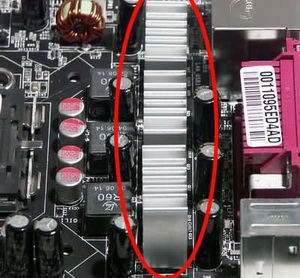| « | » |
Cooling Southbridge and other chips
Actually everything said about the northbridge cooling is true of this case as well. So in this chapter I will dwell on some other things. Namely: frequent users' delusions. But I associate these "delusions" more often with the southbridge than with the northbridge not without a reason, you can still come across a motherboard without southbridge cooling, and that suggests some ideas... So, delusions. What's the most important, it's terribly naive to think that in 100% cases heatsinks are installed on chips because they really need cooling. They can be installed for many reasons, which have nothing to do with technical necessity (or related to it in a very perverse manner...).
- A motherboard "for overclockers" may have this heatsink just to show off its overclocking nature. It costs twopence after all, while this overclocking nature can bring plump dollars (or even dozens of dollars). If you think I'm paranoid... Well, consider what you like...
- A heatsink may be installed because motherboard engineers had low spirits and did a gross mistake in the PCB layout. This mistake resulted in overheated elements, which should have been cool in normal conditions. However, if they found it too late, it's sometimes much cheaper to install a heatsink than to redesign the PCB and reject as defective all manufactured motherboards.
- The most harmless variant: a heatsink may be installed on a motherboard "for overclockers", because the chip really starts overheating in overclocked mode. And if you don't overclock the board, this heatsink is not necessary. Thus, if you are not an overclocker, it will be of no use to you in this case.
The general conclusion suggests itself: a heatsink on a chip cannot be considered a guarantee sign of a "good" motherboard, especially if similar motherboards from other manufacturers are not equipped with heatsinks. If the chip has no heatsink, then the manufacturer considers it not necessary. It may well be right. On the other hand (see Delusion 2), a heatsink can hide a design negligence. That is it may not be actually necessary, but this given model requires it because of its bad design. And now reread the first sentence in this paragraph...
However, there is one (just one!) exception from the above said. The only place where heatsinks are always welcome and even required is MOSFET of the VRM module, responsible for CPU power supply (see Photo 8). Moreover, a motherboard "for overclockers" without them is just a parody. Why am I so categorical? Well, because there are almost no low-power processors left, even in the low end sector, and these black rectangles are used to deliver power for the CPU. They are always hot. You can try and touch them on an operating motherboard (be careful though). Cooling them is always useful. If you overclock your motherboard, especially if you raise voltage – it's practically mandatory. The funniest thing is that I don't always see MOSFET heatsinks, even on motherboards designed for "mega overclockers". What's still funnier is that this chip (one of the most exigent to cooling) is just a regular transistor (Metal Oxide Semiconductor Field-Effect Transistor).

Photo 8. It's easy to guess that the heatsinks cover MOSFETs.
What else can it be?
| « | » |
February 1, 2004
[an error occurred while processing this directive]